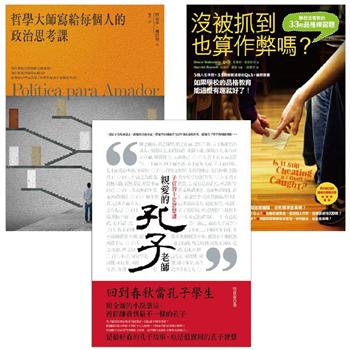最完整的英文文法及寫作學習指南!一套四冊,編排層級分明,循序漸進以清楚圖表、豐富例句與實用範例,啟動自主學習!
◎ The set of 4 books points out the systemic differences between Chinese and English language and is packed with specific explanations, clear-cut examples and useful suggestions that can be used to write grammatically correct English with immediate effect.
◎ 將漢語及英語的系統組織作大體上的比較和分析,對英語文法作全面探討。
◎ 從基礎詞語和片語、文法重點,到句子結構、段落鋪陳、寫作技巧,所有寫作的黃金規則一應俱全!
◎ 打破英語寫作恐懼,循序漸進,引起高度自主學習動機。
◎ aim at helping Chinese ESL intermediate-level learners to learn the distilled essence of English grammar with colourful diagrams and lots of examples
◎ illustrate major grammar rules in manageable pieces to enhance learning
◎ demonstrate the detailed requirements and skills for forming words, phrases, sentences as well as paragraphs
◎ provide a comprehensive guide to writing good English essays easily
本書一盒四冊,共分八章,由中文與英文文法系統的區別開始,到英文單詞、片語以及句子的組成、種類、構造分析,一步步帶領讀者進入寫作的方法;由基本的寫作策略、起承轉合到常用的文體、範例、套用句型、片語、鞏固練習等,帶領讀者深入淺出抓住英文句型的概念及核心,有效提升英文寫作的表達的實力。
內容適用大學英語學測、香港高中文憑試、雅思丶托益、托福、或各種形式的英文寫作考試,豐富範例與重點提示,讓讀者加深印象,靈活運用,變化出各種句子,進而鋪成完整而段落分明的文章;內容符合讀者自主學習所用,讓讀者親切掌握英文寫作技巧。
ESL English Grammar Prescriptions is a set of 4 books from Book A to D and these “prescriptions” provided within are a collection of grammatical rules, explanations, examples and suggestions on the usage of English. The set of books is not intended to teach the language but skills to learn the language, providing the scaffolding necessary for readers to build up their language competence by themselves. The books are designed as easy reference materials and each of the books is made up of two sections, so there are eight sections altogether. Each section on points of grammar begins with the checklists of what learners are going to learn, followed by some useful rules, and examples to enhance understanding. The definitions and discussions are not exhaustive; they can be treated as rules of thumb and mnemonic stimuli.
In Section 1 of Book A, a global picture of the basis of English grammatical structures and systemic differences between the target language and Chinese language is presented. When learning a second language with insufficient language exposure or immersion, one has to be trained to develop competence and then be able to apply it and create responses in an infinite number of new ways. So, this is about how learners are capable of using the target language to express their ideas and thoughts. Their competence is defined by the grammar, or set of language rules, that is represented mentally and established based on his or her own understanding of acceptable usage in a given linguistic context. The core components of the grammar are included in the learner’s linguistic competence and these components relates to the four subfields: Phonology, Morphology, Syntax and Semantics.
Developed from the concept of these four subfields, Section 2 to 7 provide explanations and prescriptions for those who really want quickly enhance their English language skills. Details of grammar items are explained in terms of letter, word, phrase, clause, sentence, paragraph and other requirements of an essay, from the smallest unit developing progressively to the largest element of an essay. The final Section 8 keeps a glossary of some grammatical terms, a list of analogical figures used and the suggested answers to the essay analysis. As the characteristic of English grammar is that to fully understand one term, learners need to also know what the other terms mean, thus they could opt to familiarize themselves with the terms and figures before reading Section 1 to 7. All in all, improving one’s grammar skills will give one a boost of confidence as one find oneself reading and writing with ease.
| FindBook |
|
有 1 項符合
Wong Man Yi Nikki的圖書 |
| |
$ 880 | ESL English Grammar Prescriptions: Simplified Version
作者:Wong Man Yi Nikki 出版社:智識藝品 出版日期:2014-10-01 語言:繁體/中文  看圖書介紹 看圖書介紹
|
|
|
圖書介紹 - 資料來源:博客來 評分:
圖書名稱:ESL English Grammar Prescriptions: Simplified Version
內容簡介
作者介紹
作者簡介
黃敏儀
作者自幼對閱讀及終身學習有一份執著。中學時已對英國語文萌發興趣,中五後遠赴英國進修商科及英語。回港曾從事不同行業,1999年移民加國,在當地一所小學及成人教育中心助教英文,主要協助以英語為第二語言的新移民人士。回流香港後,為達成兒時夢想,在香港大學修讀四年制教育學士課程,2007年正式成為全職日校英文老師,並於2012年完成英語教學文學碩士課程。同年獲香港公開大學聘請,擔任大學英語講師至今。
多年來致力把這錯綜複雜的英語文法簡化,運用圖像解說,令讀者腦印象加深。又融合美學徵表及以數學邏輯來分析文句結構,期望打破語文學習的沉悶和窒礙,提升讀者學習英語的效能。
Nikki Wong was born in 1961 and raised in a tiny flat like most Hongkongers during those days. She left Hong Kong and studied English and Business Studies in the UK immediately after graduating from secondary school. When she returned to Hong Kong, she worked in succession several jobs such as being a sales representative, a librarian, a police officer and an assistant departmental secretary for the Hong Kong Treasury Department. Afterwards, she operated her own trading company for around 9 years before moving to Canada with her sons. There she worked as a teaching assistant at her sons’ school and at an adult learning centre helping new immigrants.
Upon returning to Hong Kong, she worked to realize her dream to be an English teacher, so she studied for a Bachelor of Education full-time degree program at the University of Hong Kong, graduating in 2007 after 4 years of study and practice. During this time, she taught part-time at a private tutoring centre to fund her university degree as well as to earn some work experience in this field. Later on, she became a full-time English teacher at a local secondary school and taught English and Career and Life Skills for 5 years. In 2012, she obtained her Masters degree in Teaching English to Speakers of Other Languages (TESOL) and started teaching university English courses at the LiPACE of the Open University of Hong Kong until present.
黃敏儀
作者自幼對閱讀及終身學習有一份執著。中學時已對英國語文萌發興趣,中五後遠赴英國進修商科及英語。回港曾從事不同行業,1999年移民加國,在當地一所小學及成人教育中心助教英文,主要協助以英語為第二語言的新移民人士。回流香港後,為達成兒時夢想,在香港大學修讀四年制教育學士課程,2007年正式成為全職日校英文老師,並於2012年完成英語教學文學碩士課程。同年獲香港公開大學聘請,擔任大學英語講師至今。
多年來致力把這錯綜複雜的英語文法簡化,運用圖像解說,令讀者腦印象加深。又融合美學徵表及以數學邏輯來分析文句結構,期望打破語文學習的沉悶和窒礙,提升讀者學習英語的效能。
Nikki Wong was born in 1961 and raised in a tiny flat like most Hongkongers during those days. She left Hong Kong and studied English and Business Studies in the UK immediately after graduating from secondary school. When she returned to Hong Kong, she worked in succession several jobs such as being a sales representative, a librarian, a police officer and an assistant departmental secretary for the Hong Kong Treasury Department. Afterwards, she operated her own trading company for around 9 years before moving to Canada with her sons. There she worked as a teaching assistant at her sons’ school and at an adult learning centre helping new immigrants.
Upon returning to Hong Kong, she worked to realize her dream to be an English teacher, so she studied for a Bachelor of Education full-time degree program at the University of Hong Kong, graduating in 2007 after 4 years of study and practice. During this time, she taught part-time at a private tutoring centre to fund her university degree as well as to earn some work experience in this field. Later on, she became a full-time English teacher at a local secondary school and taught English and Career and Life Skills for 5 years. In 2012, she obtained her Masters degree in Teaching English to Speakers of Other Languages (TESOL) and started teaching university English courses at the LiPACE of the Open University of Hong Kong until present.
目錄
Book A: WORD
Section 1: A Holistic View
I. English Grammar
II. Learning English from 3 Perspectives
III. Golden Rules to Remember
IV. The Birth of an English Essay
Section 2: The Creation of a Word
I. Word Formation
II. Phonology – Letters & Sounds
III. Morphology – Parts of a Word
IV. Various Ways to Make a Word
V. Word Classes
Book B: PHRASE
Section 3: The Concept of Phrases
I. What is a Phrase?
II. The Integral Phrases
III. The Additional Phrases
IV. The Verbal Phrases
Section 4: To Form A Main Clause
I. Basic Concepts – the 4 Big Groups
II. Active or Passive Voice
III. What is a Complete Sentence?
IV. Modification
V. Details of Each Constituent
Book C: CLAUSE
Section 5: The Sentence Structures
I. Three General Types
II. Samples of 5 Basic Clause Patterns
III. Simple Sentence Structure Analysis
IV. Dependent / Subordinate Clauses
V. Review of Sentential Elements
Section 6: Different Grammatical Moods & Other Requirements
I. Writing Sentence
II. Two Categories of Questions
III. Other requirements within a Clause
IV. Different Grammatical Moods
V. Modification of a Clause
VI. Different Sentence Functions
VII. Capitalization & Punctuation
Book D: ESSAY
Section 7: Final Stage of an Essay
I. Constituents of an Essay
II. Writing Paragraph
III. The Process of Writing
IV. Different Genres
V. Proof-reading Essay
VI. Consolidation
Section 8: Appendixes
I. Glossary of Grammatical Terms
II. Analogical Figures
III. Suggested Answers
Section 1: A Holistic View
I. English Grammar
II. Learning English from 3 Perspectives
III. Golden Rules to Remember
IV. The Birth of an English Essay
Section 2: The Creation of a Word
I. Word Formation
II. Phonology – Letters & Sounds
III. Morphology – Parts of a Word
IV. Various Ways to Make a Word
V. Word Classes
Book B: PHRASE
Section 3: The Concept of Phrases
I. What is a Phrase?
II. The Integral Phrases
III. The Additional Phrases
IV. The Verbal Phrases
Section 4: To Form A Main Clause
I. Basic Concepts – the 4 Big Groups
II. Active or Passive Voice
III. What is a Complete Sentence?
IV. Modification
V. Details of Each Constituent
Book C: CLAUSE
Section 5: The Sentence Structures
I. Three General Types
II. Samples of 5 Basic Clause Patterns
III. Simple Sentence Structure Analysis
IV. Dependent / Subordinate Clauses
V. Review of Sentential Elements
Section 6: Different Grammatical Moods & Other Requirements
I. Writing Sentence
II. Two Categories of Questions
III. Other requirements within a Clause
IV. Different Grammatical Moods
V. Modification of a Clause
VI. Different Sentence Functions
VII. Capitalization & Punctuation
Book D: ESSAY
Section 7: Final Stage of an Essay
I. Constituents of an Essay
II. Writing Paragraph
III. The Process of Writing
IV. Different Genres
V. Proof-reading Essay
VI. Consolidation
Section 8: Appendixes
I. Glossary of Grammatical Terms
II. Analogical Figures
III. Suggested Answers
序
作者序
本書專為以英語為第二語言和有心加強英文寫作能力的大眾而設計。首先介紹各種基礎詞語、文法重點,從詳細的英詞和文法解說開始,逐步引導讀者學習句子的結構,並藉由豐富的範例和重點提示,讓讀者加深印象,學會靈活運用各種技巧和句型,變化出各式各樣的句子,進而鋪成完整而段落分明的文章。
英文寫作對於一般大眾而言或許是很大的挑戰,但只要多加練習、熟悉基礎的寫作技巧,例如:好的主題句、內容緊接的句式撰寫等,按照如此模式便熟能生巧,寫作再也不是難事。就像是連接列車般,先有了大致的外觀架構,再裝潢車廂的內部,豐富寫作的內容,使文字更加簡練、語句更加順暢。
不論是想講一個生動的故事、想對一個印象深刻的事物詳盡地描寫、想和人闡述自己對某個事物的推理與觀點、想彙整和統合一連串零散的文字、想理直氣壯的和人理論、想對一個特別的事物作解釋、乃至於生活上的種種情境,都需要穩健的寫作、文法和句法的基礎;而英文是如此一個國際化的語言,駕馭英文的好處與價值相信大家也都有目共睹,在此不多加贅述。
本書雖經盡心編撰和仔細地校對,仍難免有疏漏之處,還請各位讀者不吝指正,使這本書更臻至完美。謝謝!
Learning English for 40 odd years has given me the valuable knowledge, inspirations and eagerness to improve further as well as to make the study of this second language easier for my fellow students. Being an English as a second language (ESL) learner myself, I strongly recommend students to learn Phonics so as to build up their own vocabulary bank and articulate their speech accurately. As for English grammar, they should learn the construction system and read extensively to gain the necessary skills.
The task of constructing error-free English is complex and we should not underestimate the systemic differences between Chinese and English. For writers whose first language is not English, the tendency to draw on grammatical and lexical patterns from the first language makes the avoidance of error even more a matter of careful attention to detail. In order to write grammatical correct English, it is important to be able to recognize the basic differences in the characteristics of Chinese and English that may lead to confusion.
It was with these thoughts in mind that I took to writing a simplified English grammar reference book with lots of pictographs and explanations as well as examples to elucidate the complex usage of the language and provide a holistic view of its grammar formation. To begin with, I provide the ‘global’ picture of the basis English and its grammatical system for readers to get familiar with and to freshen up their existing knowledge so that they feel secured before proceeding to more complicated structures. I mean to lead readers to grow little by little and phase by phase towards the ultimate pragmatic goal – writing.
本書專為以英語為第二語言和有心加強英文寫作能力的大眾而設計。首先介紹各種基礎詞語、文法重點,從詳細的英詞和文法解說開始,逐步引導讀者學習句子的結構,並藉由豐富的範例和重點提示,讓讀者加深印象,學會靈活運用各種技巧和句型,變化出各式各樣的句子,進而鋪成完整而段落分明的文章。
英文寫作對於一般大眾而言或許是很大的挑戰,但只要多加練習、熟悉基礎的寫作技巧,例如:好的主題句、內容緊接的句式撰寫等,按照如此模式便熟能生巧,寫作再也不是難事。就像是連接列車般,先有了大致的外觀架構,再裝潢車廂的內部,豐富寫作的內容,使文字更加簡練、語句更加順暢。
不論是想講一個生動的故事、想對一個印象深刻的事物詳盡地描寫、想和人闡述自己對某個事物的推理與觀點、想彙整和統合一連串零散的文字、想理直氣壯的和人理論、想對一個特別的事物作解釋、乃至於生活上的種種情境,都需要穩健的寫作、文法和句法的基礎;而英文是如此一個國際化的語言,駕馭英文的好處與價值相信大家也都有目共睹,在此不多加贅述。
本書雖經盡心編撰和仔細地校對,仍難免有疏漏之處,還請各位讀者不吝指正,使這本書更臻至完美。謝謝!
Learning English for 40 odd years has given me the valuable knowledge, inspirations and eagerness to improve further as well as to make the study of this second language easier for my fellow students. Being an English as a second language (ESL) learner myself, I strongly recommend students to learn Phonics so as to build up their own vocabulary bank and articulate their speech accurately. As for English grammar, they should learn the construction system and read extensively to gain the necessary skills.
The task of constructing error-free English is complex and we should not underestimate the systemic differences between Chinese and English. For writers whose first language is not English, the tendency to draw on grammatical and lexical patterns from the first language makes the avoidance of error even more a matter of careful attention to detail. In order to write grammatical correct English, it is important to be able to recognize the basic differences in the characteristics of Chinese and English that may lead to confusion.
It was with these thoughts in mind that I took to writing a simplified English grammar reference book with lots of pictographs and explanations as well as examples to elucidate the complex usage of the language and provide a holistic view of its grammar formation. To begin with, I provide the ‘global’ picture of the basis English and its grammatical system for readers to get familiar with and to freshen up their existing knowledge so that they feel secured before proceeding to more complicated structures. I mean to lead readers to grow little by little and phase by phase towards the ultimate pragmatic goal – writing.
|











